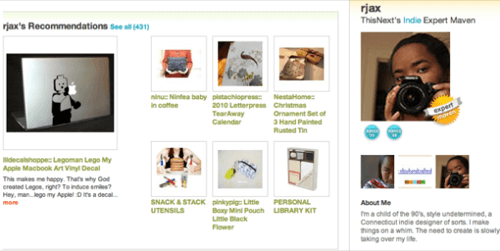What are you going to buy this holiday season? Gift cards aren’t very personal, but friends’ recommendations can be.

Richard MacManus recently covered the trends in e-commerce over the past decade. He noted that Amazon and eBay have dominated the online retail market with their model of using implicit user data to generate recommendations for others. Although this model will surely remain a centerpiece of the online retail experience, it may soon face competition as “social shopping” takes off.
This guest post was written by Brynn Evans.
What is social shopping? This is similar to the question of “What is social search,” which I addressed previously by describing the three flavors of social search: what they are, why they’re relevant and how they will help you search better. The Amazon and eBay model of online retail tapped into what I refer to as “collective social search.” Social shopping, on the other hand, is more like “friend-filtered social search.”
In social shopping, you see recommendations and reviews that your friends have shared. You see items that your friends have purchased or brands that your friends have shopped with. This matters a lot when you’re shopping for a digital camera and are stuck deciding between three different models. Of course, the last 10 years’ worth of people’s purchasing histories and written reviews on Amazon may help you narrow your choice – if you can filter out the noise. But those reviewers are entirely anonymous to you, even though they may use a real name and have a rating history with the site.
The decision you are making, as with most decisions, will carry consequences going forward, which is a part of the reason why collective intelligence can’t provide the necessary emotional “spark” in quite the way that a personal recommendation can. Patricia Mejia, a commenter on Richard’s e-commerce trends post, explained why she wants this in shopping: “I want to be inspired, intrigued and entertained when I shop online.”
Algorithms don’t provide that emotion. But a recommendation from a friend just might.
Plus, users increasingly expect this, and the larger and more connected our networks become, the more powerful this social shopping model will be. What are the social shopping services that do this best today? (Hint: not Amazon.)
Sites like ProductWiki are devoted to product comparisons, but their user base is most likely not your peer network. ThisNext and Kaboodle lie closer to the intersection of social media and e-commerce. They are predominantly social networks dedicated to sharing products and personal reviews.
Kaboodle’s user profile for “aplyler” closely resembles other social networking sites, and the site provides functionality for creating product lists, commenting on items and, of course, adding friends.

On ThisNext, users’ recommendations are featured front and center on their profiles. Here, “rjax” has been promoted to “Expert Maven” because of her extensive collection of recommended items. Unfortunately, the collection’s range is so vast that you probably wouldn’t care about the Christmas ornaments if you liked her review of the Macbook art decal.

Thus, the limitation with sites like ThisNext and Kaboodle is that you, your friends and the products you’re going to buy all exist on those sites. In other words, the sites are social shopping silos.
RunToShop, on the other hand, brings a distributed social networking model to social shopping. A small Finnish startup, RunToShop aims to bring social recommendations to you wherever you may be, and from the friends in your network who you trust.

This means that if you’re shopping for golf clubs on Smart Golf, recommendations will be embedded on the site through the RunToShop widget. Currently, all user reviews are shown, but in the next release, recommendations from friends will be prioritized. (You can pull in your friends with Facebook Connect.)

RunToShop also integrates with Facebook. So, if Facebook is where you spend most of your time, you can browse product offerings and friends’ recommendations directly through the RunToShop Facebook app.
Finally, its distributed social networking platform allows your product reviews to percolate out to other sites where those products exist. If your long-lost sister, for example, discovers one of these products through LinkedIn, she can view your recommendation right there.
Based on most of the services I’ve seen to date, including RunToShop, the implementation and user experience around social shopping still has a long way to go. In the meantime, keep this in mind the next time you’re shopping for the right social shopping service: will it provide the emotional spark you need?
Guest author: Brynn Evans is digital anthropologist, design researcher and author who studies social interaction design and social search.
















